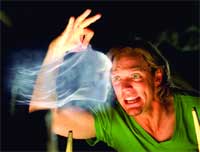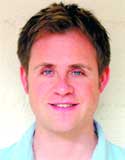
Giant Killer Robots spent eight months working on the 120 effects shots associated with Scooby-Doo's "cauldron of souls" sequence.
|
SAN FRANCISCO - Ok, let's connect the dots... Peter Oberdorfer and John Vegher were just minding their business studying architecture at Columbia University when they got a call to work on CG buildings for the film Judge Dredd. "It was one of those fateful choices that sent me away from architecture into visual effects," recalls Oberdorfer. Vegher, Oberdorfer and Mike Schmitt started Pixel Liberation Front in 1994 but parted ways with the studio in 1997 to form Giant Killer Robots, or GKR (www.giantkillerrobots.com), in San Francisco, where they worked on the movie What Dreams May Come. That film earned the 1999 Oscar for visual effects. In 1999, GKR hooked up with visual effects supervisor Peter Crosman and worked with him on the effects for Henry Selick's Monkeybone. In 2001, Crosman got the gig creating some visual effects shots for Scooby-Doo, and viola, GKR is cranking out 2K renders on the Warner Bros. feature.
"We originally had the opportunity to either go for the monster characters or doing the soul characters," explains Oberdorfer. "We chose to do the soul characters because they have a lot of varied effects." For the uninitiated, the "soul" characters are disembodied heads made of protoplasm that are extracted from the characters' bodies and kept in a giant cauldron. "We knew it would be a real challenge because we had to do hair, a lot of facial animation, a lot of particle stuff and lot of shader work."
GKR worked for eight months on the 120 effects shots associated with the "cauldron of souls" sequence. In addition to the individual soul heads, they produced corollary effects including streaky fireballs and trails when the souls get reunited with their bodies and the swirling ectoplasm stew inside the cauldron.
Scooby-Doo director Raja Gosnell (see www.postmagazine.com for an in-depth Q&A) and Crosman filmed just the head of each actor, fixed in place, speaking their lines in gray-white makeup with their hair slicked back. "It must have looked a little freakish for the actors," recalls Crosman, "but Giant Killer Robots did a fantastic job getting a flat 2D performance and turning it into a complete 3D scene."
GKR took the live action background plates, still photos of the actors, 360-degree cyberscans of their heads and the reference footage shot on location and built detailed CGI versions of Fred, Velma, Daphne, Shaggy and Scooby-Doo. "A lot of it was just looking into anatomical books and seeing exactly where the facial muscles were, how the face reacts," explains Oberdorfer. "You have a bunch of isolated muscles you're making work in tandem with each other so that you get convincing facial motion."

GKR's Peter Oberdorfer and crew used tools such as Maya, Commotion and Shake to create Scooby-Doo's ghostly effects.
|
Gosnell says, "Giant Killer Robots was able to make these fantastic looking ghost-like heads that look like Fred and Velma and Daphne. It was really a design challenge to get the faces and do the lipsync and get the sparkling nature of it."
According to Oberdorfer, the bulk of the work GKR did for Scooby-Doo was created in Alias|Wavefront Maya 4.0. But they needed to create hair effects. "We discovered that the new release of Softimage|XSI had a great hair package that really suited our needs. So we ended up writing converters from Maya to XSI so we could do the hair in XSI, the rest of our animation in Maya and then merge the two."
Other software GKR used on Scooby-Doo was Adobe Photoshop, Pinnacle Commotion and Shake, now owned by Apple. Adobe After Effects was used for most of the compositing. "We also used 2d3's Boujou for tracking difficult scenes and various plug-ins such as Trapcode's Shine and RE:Vision Effects' ReelSmart Motion Blur."
GKR programmers also devised proprietary artificial intelligence engines for the multiple soul objects. Each head was assigned a set of behaviors so they could motion detect around each other and have different reactions inside the vat, explains Oberdorfer. "That way we could take a few hundred souls, give them some general parameters of motion and end up animating hundreds of these objects without having to character animate each one."
Oberdorfer says one of the nice things about being a company of only 25 people is that they can still, just barely, use a Windows network. "Any larger than that and we'd need to use a Unix-based system." Running Windows 2000, he notes, allows them to use a lot of off-the-shelf software and have the in-house expertise to maintain the system.
For Scooby-Doo, their workstations and renderfarms were Wintel-based machines with dual 1.2GB AMD chips that they either built themselves or ordered from Dell or Boxx Technologies. Everything is networked via gigabyte Ethernet and some fiber connections to a central server where just the Scooby-Doo job alone took up about a terabyte of disc space.
Oberdorfer and crew are currently busy working on The Matrix Reloaded and The Matrix Revolutions. Scooby, he comments, got them into game shape for The Matrix sequels. By having all those films in-house at the same time they "kind of cross-pollinated each other."